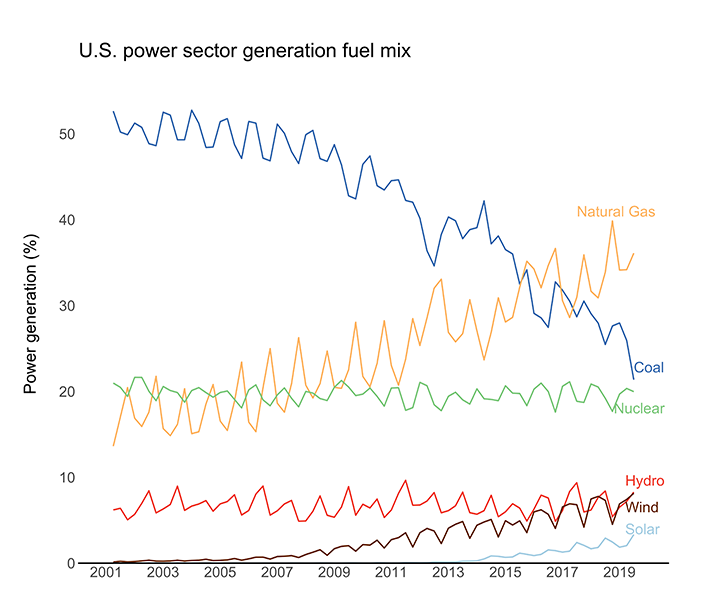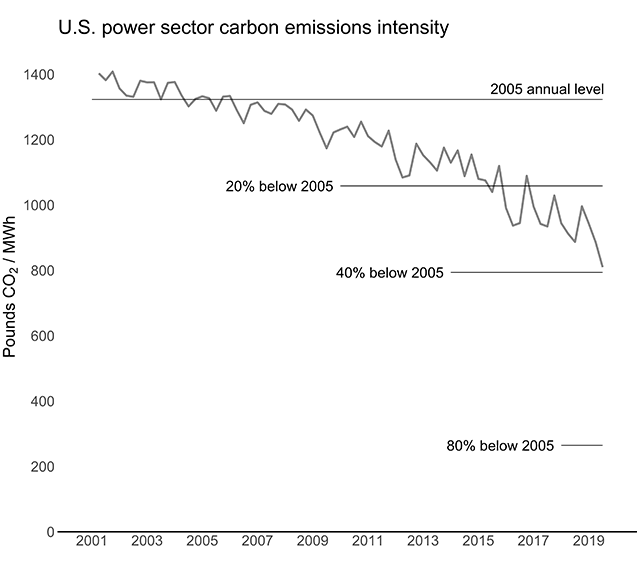A lot of things aren& #39;t great right now, and the UN report makes clear what the math shows: the window to limit global warming to 1.5 degrees C is rapidly closing: https://www.unenvironment.org/interactive/emissions-gap-report/2019/">https://www.unenvironment.org/interacti...
The challenges ahead are large, and it is not too late. I get hope from all of the folks who work everyday, whether part of their full-time jobs, or their interests, or their education, to reduce the damages from, and prepare us all for, the impacts of climate change.
We& #39;ll need a clean power sector to enable decarbonization of transport, buildings, & industry, and we track the progress of the US power sector with @Emissions_Index. Today we released the latest data, for Quarter 2 of 2019. There& #39;s hope in the results. https://emissionsindex.org/ ">https://emissionsindex.org/">...
US power sector carbon intensity was 813 lb/MWh (369 g/kWh) CO2 in 2019 Q2, down 9% compared to the same time last year. The rolling average annual intensity is 31% lower than 2005, & the total average annual CO2 from the power sector--what really matters, is down 29% since 2005.
Coal generation was down 19% in 2019 Q2 (210 million MWh) when compared to 2018 Q2 (260 million MWh). Coal represented 21% of total generation in 2019 Q2.
In 2001 coal was 50% of the electricity mix.
In 2001 coal was 50% of the electricity mix.
Wind generation was up 7% in 2019 Q2 (80 million MWh) when compared to 2018 Q2 (75 million MWh). Wind represented 8% of total generation in 2019 Q2.
People said wind power was a joke. Unworkable. Now it provides as much electricity as hydropower. You know, the big giant dams?
People said wind power was a joke. Unworkable. Now it provides as much electricity as hydropower. You know, the big giant dams?
Solar generation was up 10% in 2019 Q2 (33 million MWh) when compared to 2018 Q2 (30 million MWh). Solar represented 3% of total generation in 2019 Q2.
Solar used to be a asterisk in the national numbers. Not anymore.
Solar used to be a asterisk in the national numbers. Not anymore.
There& #39;s a lot farther the power sector has to go for decarbonization. But this transition largely happened because of the switch of coal to gas, investments in energy efficiency, & investments in both state and federal actions that enabled wind & solar to get cheaper & better.
If we can drop emissions by 29% since 2005, imagine what could be done w/ a real concerted effort. You can explore & download the data, charts, & code of the power sector carbon index here: https://emissionsindex.org/ .">https://emissionsindex.org/">... Here& #39;s a summary of the Q2 release: https://emissionsindex.org/news-events/power-sector-carbon-index-2019-q2-update.">https://emissionsindex.org/news-even... /end

 Read on Twitter
Read on Twitter



